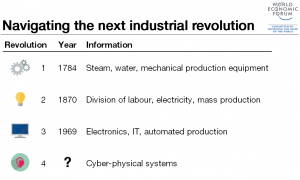 Throughout history, technological breakthroughs have created industrial revolutions that have shaped not only how we produce goods and services but also the movement of people around the world. The Fourth Industrial Revolution, also known as the New Machine Age, is no different. As increasing automation makes some jobs obsolete and additive manufacturing moves industries and jobs across national borders, these technological changes will upend the politics and economics of global labour migration. In an article for the World Economic Forum Agenda, “Will migrants and robots be competing for the same jobs?” published on November 10, 2015, I reflected on the challenges these changes will present.
Throughout history, technological breakthroughs have created industrial revolutions that have shaped not only how we produce goods and services but also the movement of people around the world. The Fourth Industrial Revolution, also known as the New Machine Age, is no different. As increasing automation makes some jobs obsolete and additive manufacturing moves industries and jobs across national borders, these technological changes will upend the politics and economics of global labour migration. In an article for the World Economic Forum Agenda, “Will migrants and robots be competing for the same jobs?” published on November 10, 2015, I reflected on the challenges these changes will present.